Last updated: October 26, 2021
Article
Backpacking in Alaska
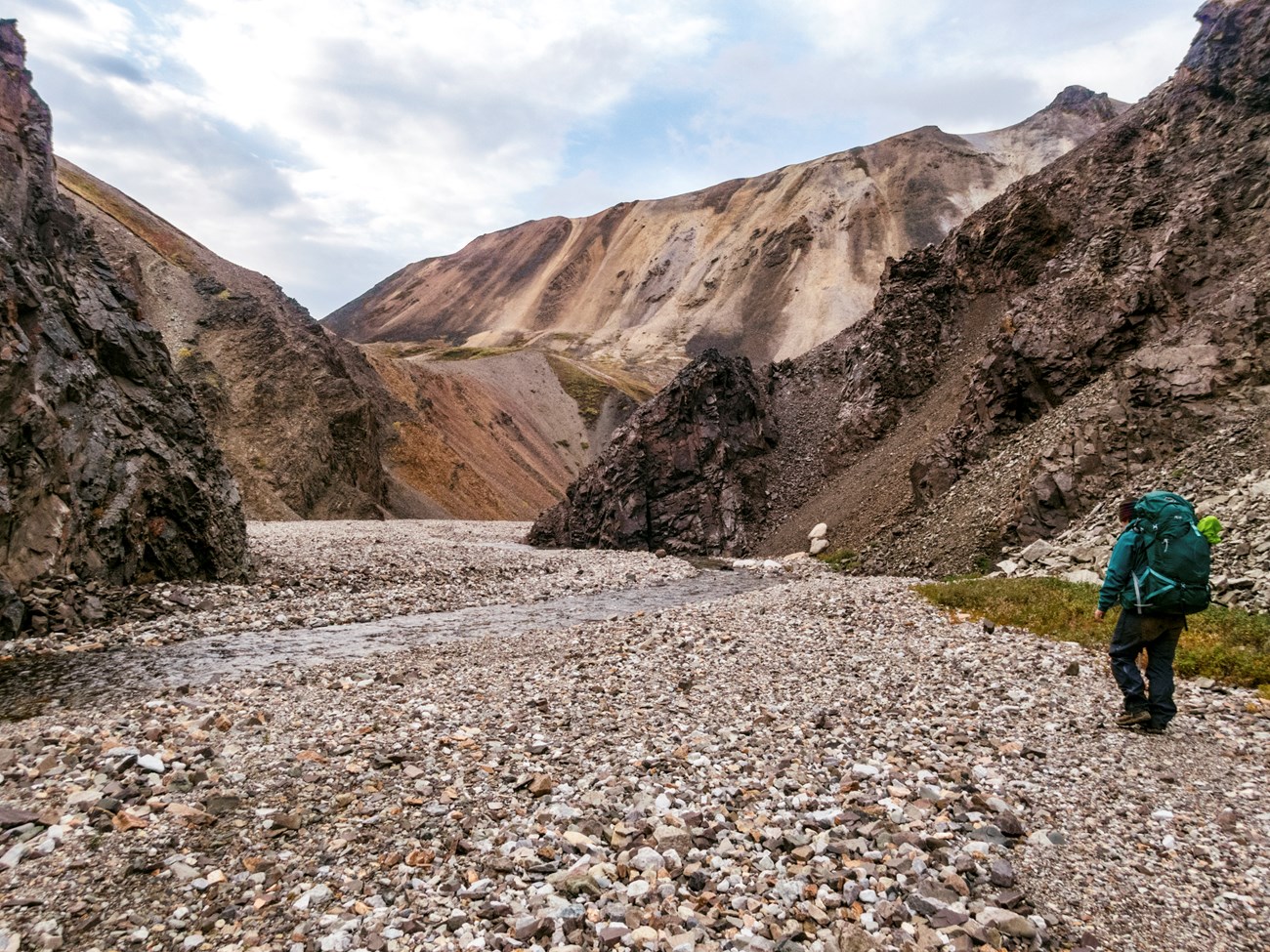
NPS / T. Vaughn
Hiking in a Remote Landscape
Alaska is large and remote. Along with this remote character comes many challenges and the need for increased preparation and orientation when hiking or backpacking. One must be self-sufficient. Much of Alaska hiking is not on trails. Even the most experienced hikers with route finding and wilderness skills are challenged in these rugged landscapes. This article will provide some backcountry pro-tips from park rangers so you can get aquainted with what makes Alaska unique before you plan your trip.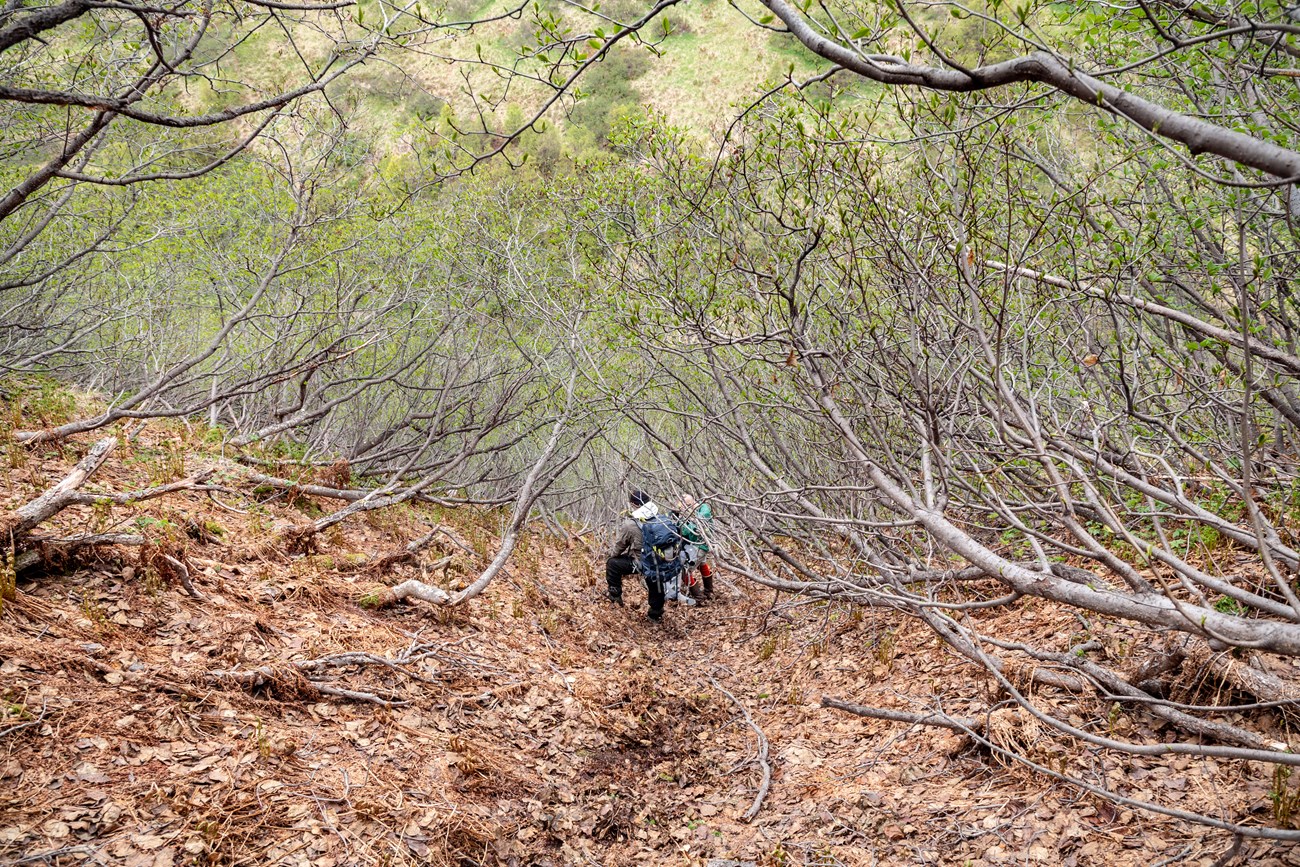
NPS / T. Vaughn
Backcountry Logistics
Food and Gear Prep: Planning is essential in Alaska, especially when fly-in backpacking. When landing in a remote area, there may not be groceries, gear or trash facilities available. You will want to have all you need ready for hiking and dispose of any trash before you load your plane or other mode of transport.
You are dependent on your own resources here. Always pack plenty of food and fuel and carry emergency food rations. Come prepared with proper equipment and clothing, including weather-resistant outerwear, thermal layers and quality rain gear. You must be ready for changing weather conditions, as they often shift rapidly. Bear resistant containers are required in most areas. Bear spray and electric bear fences are effective deterrents. If you'll be carrying these with you, it's a good idea to practice their use before you leave for your trip.
Backcountry Electronics: Batteries for electronic devices often lose charge in the cold (even in summer), so bring a battery back-up or more batteries than you think you will need. It is highly unlikely there will be a place to charge your devices once you leave a big city or village. When hiking, it can be helpful to keep your batteries in a pocket on an inside layer; this will use your body heat to keep them warm for longer periods than inside your pack.
Trip Planning: Alaskan terrain is complex, often challenging, and ever-changing. For these reasons you may not hike as fast as you normally would on a trail or other cross-country routes in the Lower 48. As you plan your trip, always add more days than you may need, especially in the case that you or your scheduled pick-up does not arrive due to weather or high river levels.
Trip planning should not be measured by “miles per day” but rather with a “you get where you get” mentality. When hiking in a landscape that is unpredictable, it is best to go with the flow, have many options for potential campsites and try to not have a required daily end point. Give yourself room to relax, have fun, move around wildlife and make safe decisions.
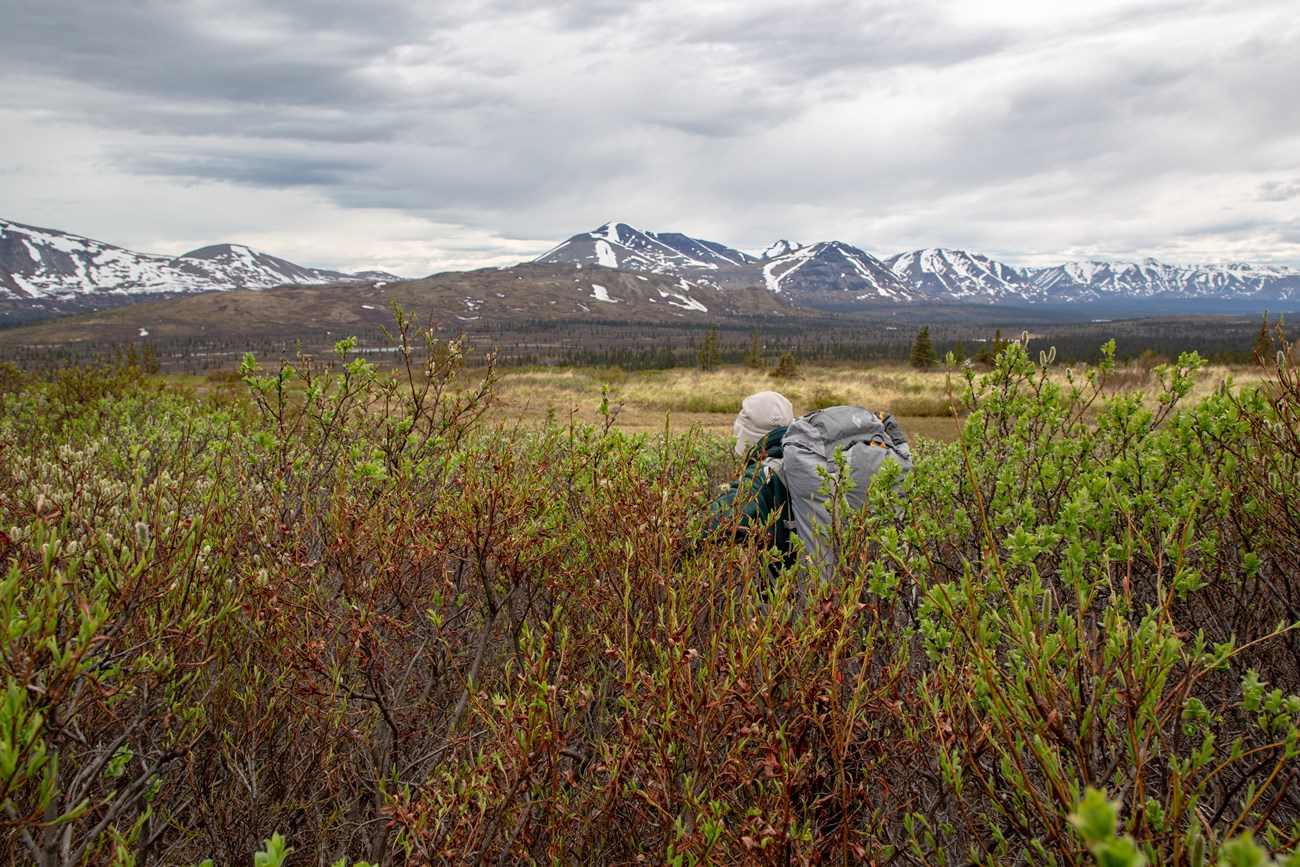
NPS / T. Vaughn
Terrain and Vegetation
There are various terrain types in Alaska’s trail-less wilderness. Plan on covering roughly one mile per hour to allow for errors in navigation, route selection and tough going. Vegetation types can dictate the difficulty of hiking and can affect how many miles you may be able to go in a day. If you're not familiar with Alaskan terrain, be prepared to turn back and try a different routes. Give yourself plenty of time to get where you're going. You may encounter the following:
-
Steep scree slopes with loose, sharp rocks.
-
Wet, muddy bogs where feet can sink into the ground up to your knees. This is often very slow hiking, usually found in low lying areas and very buggy.
-
Tussocks, brushy and lumpy areas with uneven terrain and “ankle busting” hopping from one frost heave to the next.
-
Tundra, with ankle to knee-high brush, generally more “easy going” for Alaska.
-
Dense brush, with expert-level bushwacking. Thick, waist-to-overhead height alders and willows. This can be very frustrating and slow going for long periods. Bushwhacking is often unavoidable and requires both practice and patience. Willow and alder habitats can drastically impact your speed. When traveling through willow habitats be cautious of objects or gear hanging from your pack, stow away trekking poles.
-
Fast and cold glacial waterways that must be forded by foot or packraft. Often their depth is obscured by glacial sediment.
-
Long stretches of exposed coastline. Be sure to consult tide tables and know whether the tide is rising or falling. If you are planning to hike along coastlines, you may have to hike when the tide is low. Be aware of changing tides and routes that may be impassable, either because large mudflats or high water.
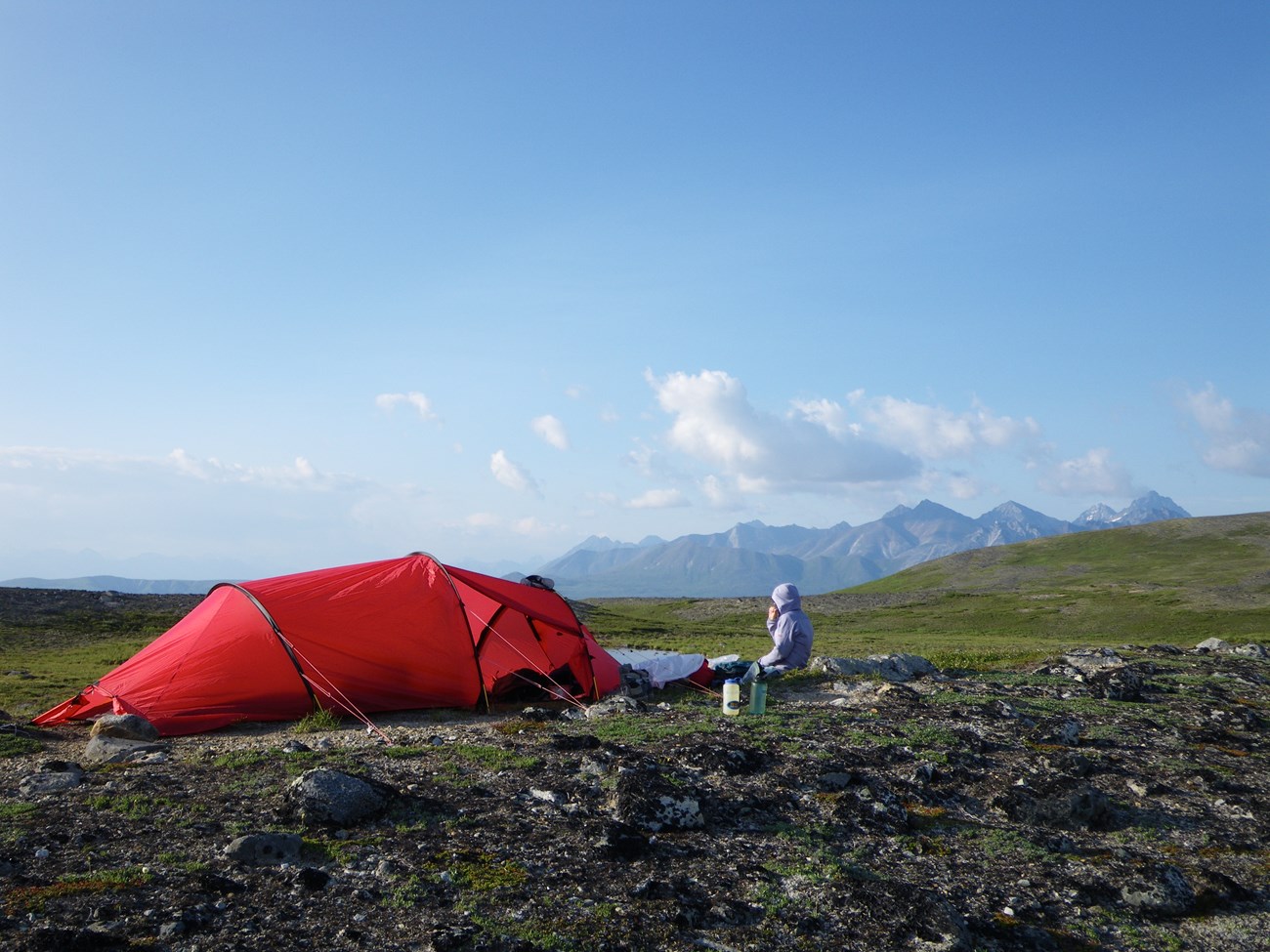
NPS / A. Lindholm
Hazards
Wildlife: Most of Alaska is bear country. Stay safe around brown bears. Avoid areas frequented by bears and avoid bear travel corridors along lakeshores and salmon streams or near game trails. Learn how to respond in the likely event that you will encounter a bear or a bear comes to your camp. Know the food storage requirements in the area you will be hiking.Place your campsite in an area of good visibility for both you and the bears to see each other and avoid surprises. Avoid cooking and eating overly odorous food or fish. Sleep, eat, and store your Bear Resistant Container (BRC) in different locations.

NPS / Lake Clark NP&P
Where the Wild Things Are
Staying Safe in Bear CountryOrientation: Have a map and compass with you and practice orienteering before you go. While electronics are convenient, do not rely on cell service or your GPS to know where you are. Most of Alaska does not have cell service and even GPS can fail in mountainous terrain.
Aviation: Much of Alaska is not on the road system. Many areas can only be accessed by small aircraft. When beaches are not suitable for a wheeled plane to land, floatplanes are an alternative means of transportation. In winter, planes operating on wheels or skis can land on lakes if ice conditions are suitable. Be prepared for the possibility of inclement weather delaying a scheduled take-off or pick-up, maybe even by days. Know the basics of safe flying so as a passenger you ask questions and can take control of your own safety.
It takes everyone
Aviation SafetyWeather: It can snow any day of the year in many places throughout Alaska. Every year is different. Snow usually falls between late August and early June. Be cautious of snow bridges during break-up and spring melt season. Both warm weather with rapid glacial melt and heavy rainfall can cause rivers to swell, making them unsafe to float.
Cold Water: Alaska has many large bodies of water and wild rivers. Rivers are very cold, swift and remote. Rivers do not have bridges and must be forded on foot or by packraft. Stream and river crossings can be dangerous. Some crossings may be impossible during spring melt or periods of heavy rain. Employ safe river crossing techniques and always give full consideration to the area, local conditions and personal ability. Always scout for the best crossing, looking for wider sections where the water is shallower and moving with less force.
Drinking Water: Be prepared to treat, boil, or filter your drinking water. You are often far away from villages or towns in the backcountry, but this does not mean the water in creeks, streams, or lakes is okay to drink. Assume that various microscopic parasites could be present in natural water sources, especially in areas or where animals frequent. If boiling water, be prepared with enough fuel to boil for up to two minutes. If you bring a filter, make sure it is easy to use, and will remove disease-causing organisms, like Giardia. Keep in mind filters may not work well in freezing temperatures. To prevent clogging your filter, avoid silty glacial water or let the silt settle in a water bottle and then filter the water from the top.
Cold, Swift, Remote
How to Cross a Wild River Safely
Daylight: You may have heard of Alaska as the Land of the Midnight Sun and in the summer, it truly is! During the summertime, there is much more daylight for hiking. On the longest day of the year, Alaska may have approximately 14-24 hours of sunlight. During the spring and fall, areas can lose several minutes of light per day. Winter days are significantly shorter, with the shortest day having approximately 0-5 hours of sunlight. Be mindful that the actual amount of daylight varies with surrounding mountains. In areas with tall mountains, it is often dark well before sunset and remains dark until well after sunrise. If you'll be hiking in spring, fall, or winter, don't forget your headlamp!
Mosquitos/biting insects: Mosquitos and other biting insects are common in Alaska. Be prepared with bug repellent and bug nets or use hats, long sleeve shirts and pants as a physical barrier to keep insects away from your skin.

NPS / A. Kirby
Remote Area Emergencies: Don't go it alone, hike with a friend! Make decisions with the knowledge that help, if any, may be days away. Hospitals are often a several hour flight away. You are responsible for your safety and self-rescue may be your only option.
Satellite messengers can be useful in the event of an emergency, but also have a back-up plan with your air taxi or your scheduled pick up. Leave a trip plan that includes a few alternative routes with someone who will know when you're overdue. Satellite messengers may be rented at certain outfitters throughout Alaska to add another layer of security.
Proper Waste Disposal: Follow Alaska leave no trace principles. Remember that bear resistant food containers (BRFC) may be required for overnight backcountry trips. To minimize food waste ahead of time, remember to repackage food before leaving home or flying into the backcountry.
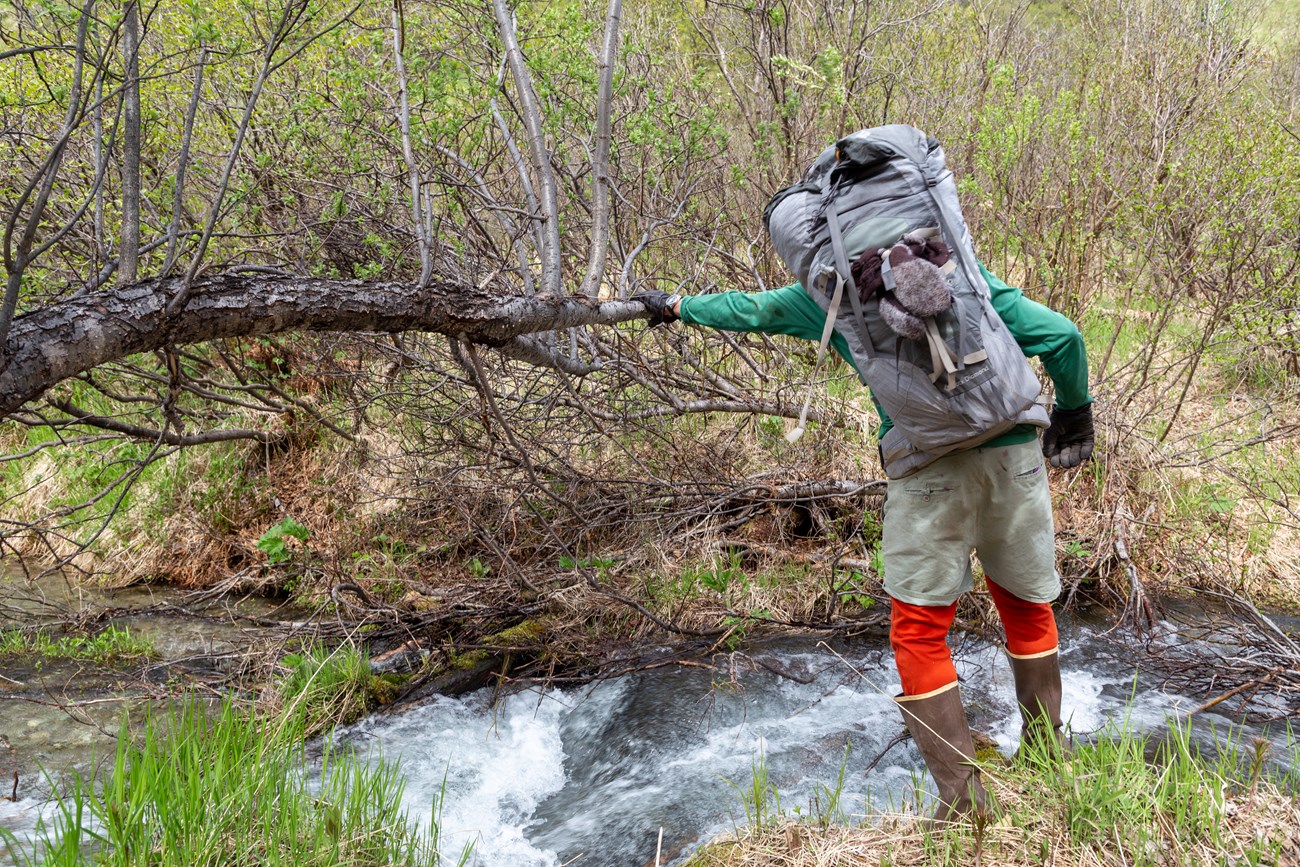
NPS / T. Vaughn
Alaskan adventures demand self-sufficiency and backcountry competence. If you master backcountry skills in this remote landscape, it may unlock a lifetime of adventure, beauty, and further exploration of America's most isolated and expansive wildernesses.
